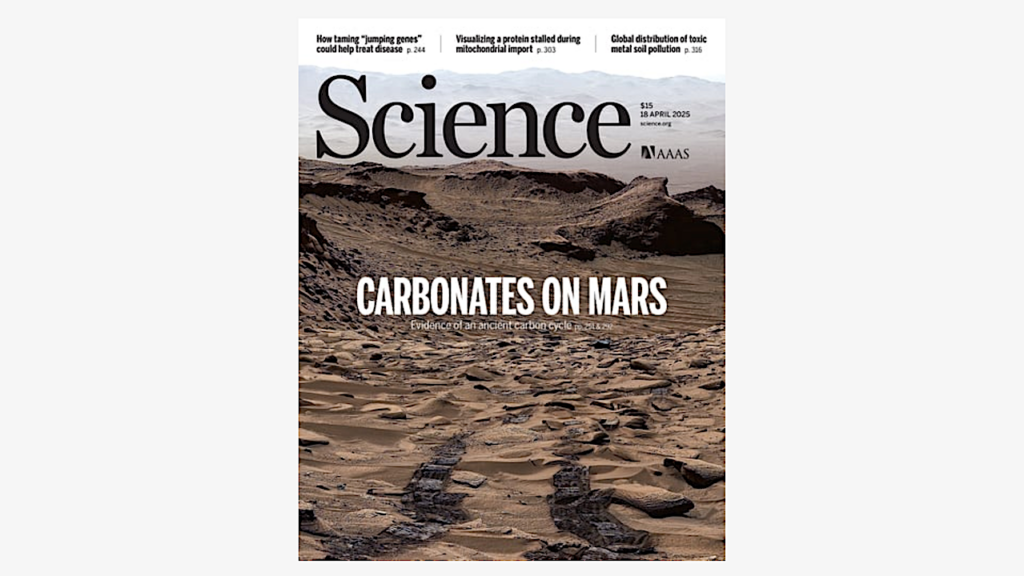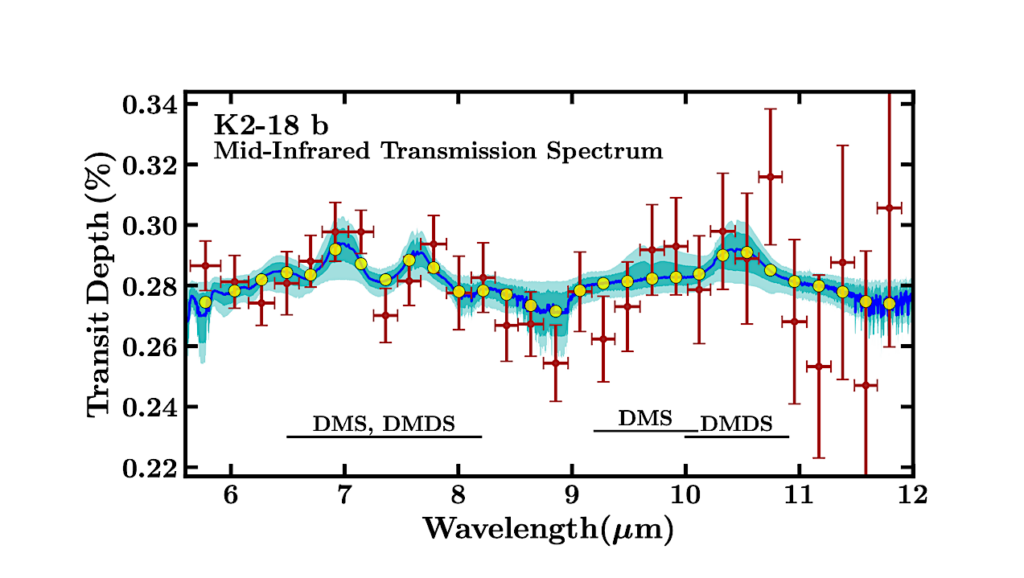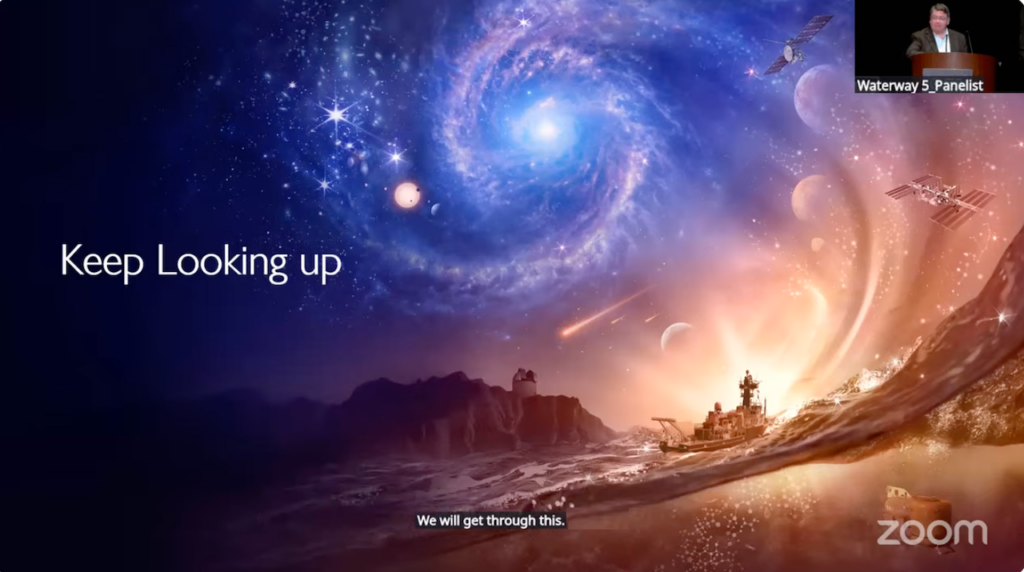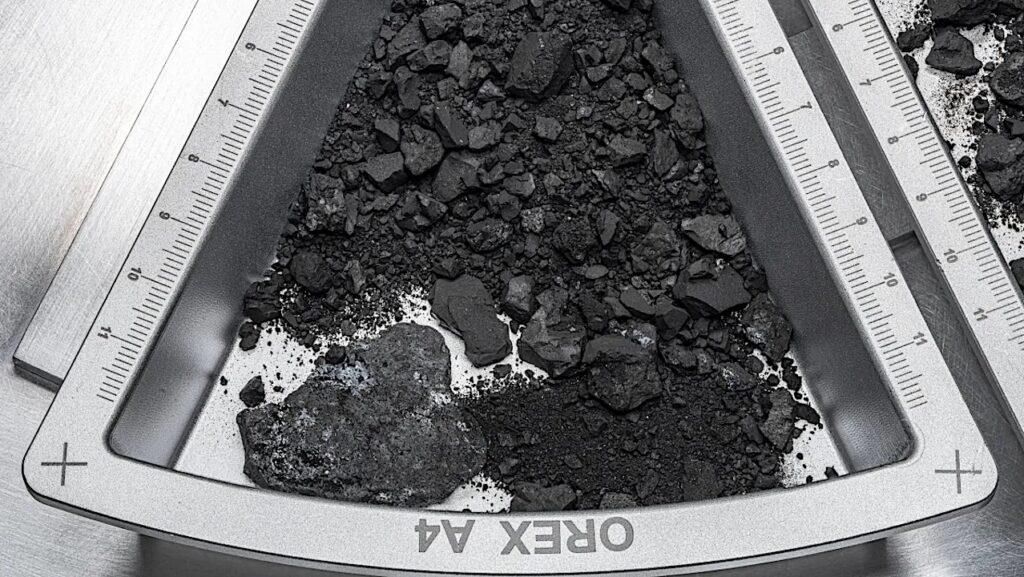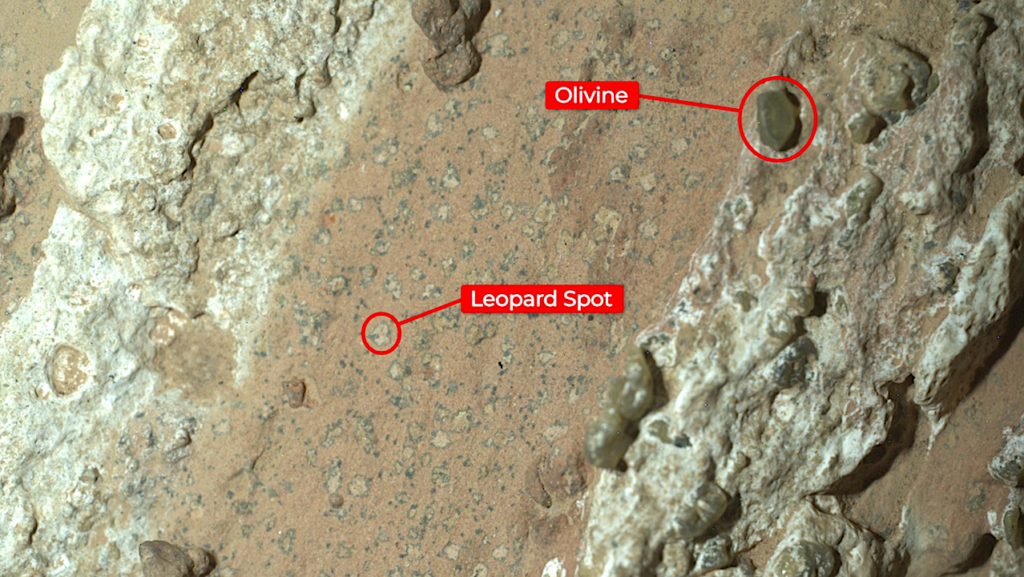Keith’s note: Wow. The Curiosity rover has been driving around Mars since 2012. Yet it still does quality field geology work. Indeed, Science Magazine saw fit to put it on its cover – a distinction where major scientific discoveries often appear. See: NASA’s Curiosity Rover May Have Solved Mars’ Missing Carbonate Mystery.
(more…)Keith’s note: I was just on Bloomberg Radio/YouTube talking about the recent (possible) biosignature news of exoplanet K2-18 b and Astrobiology, while back on Earth, NASA’s budget cuts loom and how soon-to-be NASA-administrator Jared Isaacman is going to have to figure this all out. [Audio]
(more…)Keith’s note: Some interesting news from Cambridge University. Astronomers using the James Webb Space Telescope have detected “a tentative hint of dimethyl sulfide (DMS)“. A biosignature, simply defined, is a substance that is usually produced by life. It can often also have non-life sources. But usually when it is detected in certain circumstances it is a blinking light for something interesting. Follow-up research will be required – by multiple teams. As Carl Sagan is often quoted as saying “Extraordinary claims require extraordinary evidence”. NASA helped fund this research – research that is at the core of Astrobiology. Let’s see if they talk about it. Or not. To be clear: no one has discovered extraterrestrial life. At best they have noticed the hint – of a hint – of something that is worth looking into.
- According to “New Constraints On DMS and DMDS In The Atmosphere Of K2-18 b From JWST MIRI“: “Recent JWST transmission spectroscopy of the candidate hycean world K2-18 b in the near-infrared led to the first detections of carbon-bearing molecules CH4 and CO2 in its atmosphere, with a composition consistent with predictions for hycean conditions. The observations also provided a tentative hint of dimethyl sulfide (DMS), a possible biosignature gas, but the inference was of low statistical significance. … The results also highlight the need for additional experimental and theoretical work to determine accurate cross sections of important biosignature gases and identify potential abiotic sources. We discuss the implications of the present findings for the possibility of biological activity on K2-18 b.“
- According to “Strongest Hints Yet Of Biological Activity Outside The Solar System” from Cambridge University: “Using data from the James Webb Space Telescope (JWST), the astronomers, led by the University of Cambridge, have detected the chemical fingerprints of dimethyl sulfide (DMS) and/or dimethyl disulfide (DMDS), in the atmosphere of the exoplanet K2-18b, which orbits its star in the habitable zone. On Earth, DMS and DMDS are only produced by life, primarily microbial life such as marine phytoplankton. While an unknown chemical process may be the source of these molecules in K2-18b’s atmosphere, the results are the strongest evidence yet that life may exist on a planet outside our solar system.”
Keith’s note: According to this press release issued on Monday by Rep. Judy Chu CA-28, whose district includes JPL and Caltech: “Today, President Trump’s Office of Management and Budget (OMB) reportedly sent a preliminary budget plan to NASA that proposes a 50% cut to NASA’s Science Mission Directorate (SMD) and to eliminate funding for the Mars Sample Return (MRS) mission led by Jet Propulsion Laboratory (JPL), which is owned by NASA and administered by the California Institute of Technology (Caltech).” Full text below.
(more…)Keith’s note: (This stream of consciousness bubbled out of my head on a Sunday night) One of the potential victims of the upcoming NASA budget cuts is the Mars Sample Return. Its had its problems with cost and schedule and complexity. But what if you did not need to return the samples from Mars?
(more…)Keith’s note: NASA has led space science and “Made America Great In Space” for more than half a century. Let’s not let that science leadership fade. Let’s expand it further. NASA has led the way by:
- touching the sun
- visiting every planet in our solar system
- sending humans to walk on another world
- doing the first offworld search for life
- moving an asteroid
- finding water on the Moon and Mars
- discovering oceans inside icy moons
- sailing across interstellar space
- peering back to the dawn of the universe
- developing a global brand that all nations aspire to
Keith’s note: Space Science Week 2025 – March 31-April 4, 2025 “is the joint meeting of the Space Studies Board of the U.S. National Academies discipline committees in collaboration with the Aeronautics and Space Engineering Board and Board on Physics and Astronomy.” The 1 April plenary webcast is open to anyone. According to the agenda Janet Petro is speaking at 9:20 am EDT.
(more…)Keith’s note: According to “Update to NASA Science Advisory Committees”: “On February 19, 2025, the President issued Executive Order 14217, Commencing the Reduction of the Federal Bureaucracy, which sets forth the Administration’s policy of reducing the size of the Federal government in order to minimize waste and abuse, reduce inflation and promote American freedom and innovation. This Executive Order directed the termination of several Federal advisory committees across the government and ordered the identification of additional unnecessary Federal advisory committees for termination.
(more…)Keith’s note: Heard at NASA HQ presentation at LPSC2025 tonight: “Keep looking up. We will get through this”.
(more…)Keith’s Note: According to NASA SMD: “As you may be aware, the new Administration has issued Executive Orders (EOs) and implemented policy and guidance that may affect grants, cooperative agreements, and contracts. SMD, consistent with agency direction, is working diligently to comply with the requirements of the new policy and guidance, as well as court orders resulting from litigation related to EOs and guidance. SMD currently oversees approximately 6,000 grants, cooperative agreements, contracts, interagency transfers, and internal NASA transfers; thus, as you can imagine, the process of implementing the new policy and guidance is taking some time and the turnaround time on actions will be longer than normal. We ask for your patience. Please also realize that we are in a highly dynamic environment with multiple lawsuits being adjudicated each with the potential to impact policy and guidance affecting grants, cooperative agreements, and contracts. SMD would like to provide the following brief updates:” Full memo
(more…)Keith’s note: according to this notice: “Don DeVincenzi passed away peacefully on February 14, 2025 surrounded by his family.” Where do I start? Don was a fixture at NASA Ames for decades in the exobiology / astrobiology community. And I mean decades – back to the very foundations of NASA’s search for life in the universe. I can recall in 1977 that I cold-called him – as a 22 year old community college student – to ask for some advice on pursuing a career in space science. He talked to me for 15-20 minutes. I was really energized by that – this important guy took that time to talk with me. When I arrived at NASA a decade later I would find myself in a meeting with him or reading something he wrote or studying research he had done. He was ubiquitous. Don rubbed elbows with the Carl Sagan crowd when they were figuring out the basics. Indeed, he was responsible for enabling what many of these early researchers accomplished – and what NASA’s current Astrobiology program was built upon. Ad Astra Don.
(more…)Keith’s note: According to Asteroid Bennu Sample Reveals A Mix Of Life’s Ingredients from NASA: “Studies of rock and dust from asteroid Bennu delivered to Earth by NASA’s OSIRIS-REx (Origins, Spectral Interpretation, Resource Identification and Security–Regolith Explorer) spacecraft have revealed molecules that, on our planet, are key to life, as well as a history of saltwater that could have served as the “broth” for these compounds to interact and combine. The findings do not show evidence for life itself, but they do suggest the conditions necessary for the emergence of life were widespread across the early solar system, increasing the odds life could have formed on other planets and moons.”
- Discoveries from Asteroid Bennu: Media Briefing Graphics, NASA
- Traces Of Ancient Brine Discovered On Asteroid Bennu Contain Minerals Crucial To Life , Smithsonian
- Dust From asteroid Bennu: Building Blocks Of Life And Possible Habitats Were Widespread In Our Solar System, Goethe University Frankfurt
- Exploring The Mysteries Of Asteroid Bennu, Berkeley Lab
- Pristine Asteroid Samples Reveal Secrets Of The Ancient Solar System, Curtin University
- Life’s Building Blocks Discovered In Samples From Asteroid Bennu, Hokkaido University
- More posts about Asteroid Bennu, Astrobiology.com
Keith’s note: President Jimmy carter has died. I posted this a few months ago. Carter set an example of how a former President should conduct themselves. No one has yet to come close to the example he has set. Centenarian Jimmy Carter’s Interstellar Message “Many younger people are unaware of the fact that Carter wrote a letter that is on board both Voyager spacecraft now traversing interstellar space – probably one of the longest messages a human ever sent to the stars.” Ad Astra
(more…)Keith’s note: Astrobiologist Dale Andersen is back in Antarctica – and Lake Untersee – for another field season of Astrobiology research. Dale’s work is coordinated through the SETI Institute. We’ll be posting his updates here as has been the case since the 1990s. You can find an archive of the reports here. The latest reports:
- Permafrost And Ground-ice Conditions in the Untersee Oasis, Queen Maud Land, East Antarctica (Paper)
- 14 December 2024: Departing Novo Station
- 11 December 2024: Back at Novo Station
- 20 November 2024: Live From Antarctica (webcast)
- 14 November 2024: The Plumes of Enceladus
- 5 November 2024: Evening In Antarctica (video and large panorama)
- 3 November 2024: Preparing For Science Diving (with video)
- 1 November 2024: Drilling Dive Holes Through The Ice
- 29 October 2024: Base Camp Structures
- 25 October 2024: Setting Up Base Camp (with pics and video)
- 23 October 2024: Preparing For The Traverse
- 20 October 2024: Arrival at Novolazarevskaya Station, Antarctica
- 2024 Preview: Dale Andersen’s Field Report: Preview: 2024 Lake Untersee Field Season
- That Time Star Trek Tents Were Actually Used In Antarctica
Keith’s note: Payload separation and telemetry AOS for the Europa Clipper Astrobiology expedition confirmed. Europa Clipper has begun its travels across the inner solar system for gravity assists and then outward to the Jovian system and the icy covered ocean world of Europa to search for habitable conditions that might support life. If you are a SciFi fan you may recognize this movie poster parody. Life Looks For Life. Vita quaerit vitae. Update: I was just on Deutsche Welle talking about the Europa Clipper mission – as well as ESA’s Juice mission – and how they will work in tandem exploring the icy worlds that orbit Jupiter – not unlike the polar expeditions of Earth a century ago. Fun fact: these two spacecraft are nearly the same size as the first ships that humans used to explore the arctic and antarctic. [Audio].
Keith’s note: NASA just turned 66. Jimmy Carter just turned 100. Too bad NASA does not remember its own past – a past currently being sent to the stars.
Keith’s note: NASA posted a blog update on the Europa Clipper mission and put out a tweet. Note the last sentence: “NASA’s Europa Clipper mission remains on track, with a launch period opening on Thursday, Oct. 10. The next major milestone for Clipper is Key Decision Point E on Monday, Sept. 9, in which the agency will decide whether the project is ready to proceed to launch and mission operations. NASA will provide more information at a mission overview and media briefing targeted for that same week. The Europa Clipper mission team recently conducted extensive testing and analysis of transistors that help control the flow of electricity on the spacecraft. Analysis of the results suggests the transistors can support the baseline mission.” Hmmm … “results suggest they’re ready to support our baseline mission”. Um, that’s not the same as “Yes, the transistors have been fully tested and they can fully support the mission we originally planned to do”. There is also another meeting – “Key Decision Point E” – where they give the formal go ahead to launch. I’d ask NASA PAO to clarify the wording – but they won’t respond to me – and if they do respond they will punt and tell me to wait a few weeks for the press event. So stay tuned.
(more…)“Using seismic activity to probe the interior of Mars, geophysicists have found evidence for a large underground reservoir of liquid water — enough to fill oceans on the planet’s surface. The data from NASA’s Insight lander allowed the scientists to estimate that the amount of groundwater could cover the entire planet to a depth of between 1 and 2 kilometers, or about a mile. While that’s good news for those tracking the fate of water on the planet after its oceans disappeared more than 3 billion years ago, the reservoir won’t be of much use to anyone trying to tap into it to supply a future Mars colony. It’s located in tiny cracks and pores in rock in the middle of the Martian crust, between 11.5 and 20 kilometers (7 to 13 miles) below the surface. Even on Earth, drilling a hole a kilometer deep is a challenge. The finding does pinpoint another promising place to look for life on Mars, however, if the reservoir can be accessed. For the moment, it helps answer questions about the geological history of the planet.” More: There Are Oceans Of Water On Mars. They’re Just Too Deep To Tap. Update:
Keith’s note: I will make this simple: did NASA find clear evidence of life on Mars? No. Did NASA find an interesting rock feature that might signal or indicate that there was once life on Mars? Yes. Is this a final answer? No. Not by any means. Much, much more work needs to be done. That is one of the main reasons why advanced in situ instrumentation on landers and eventual sample return missions are needed. Just remember: on Earth there are many things that look like life that are not – and there are many things that are alive that look like rocks. And that’s on Earth. What happens on Mars may be totally different. Or not. Let’s go find out more. Full story: Mars Perseverance Rover Imagery Of A Rock With Possible Biosignatures
(more…)

